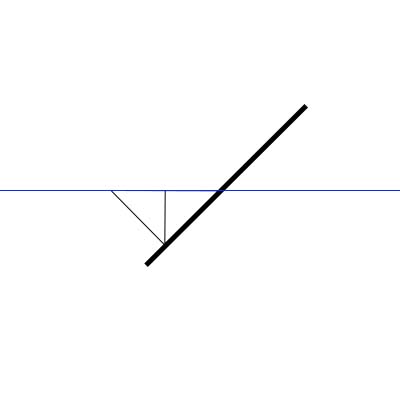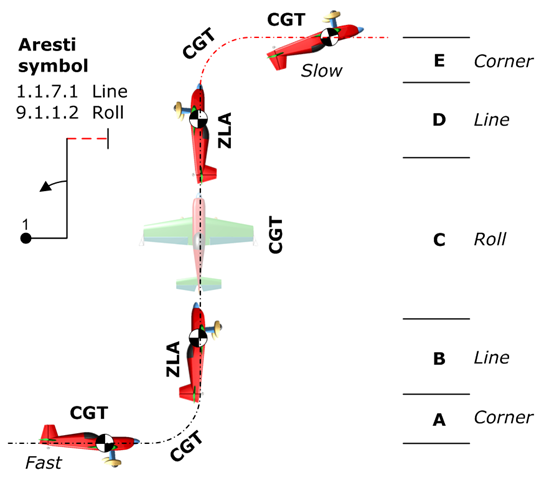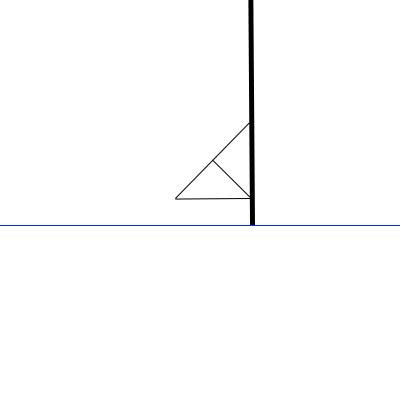In this post I will discuss how to fly an aerobatic slow roll in the horizontal, 45º and vertical plane following the CIVA judging criteria. Slow rolls are often referred to as aileron rolls to distinguish them from ‘flick’ or ‘snap’ rolls (something I will discuss in a separate post). The main difference being that in a slow roll, the rotation is primarily driven by ailerons, whereas in a ‘flick’ roll it is driven by auto-rotation caused by the application of pitch and rudder. With modern aircraft, slow rolls tend to be not very slow either, and hence why some refer to them as aileron rolls but they are typically slower than a snap roll!
There are many variations of slow rolls and they are used in a variety of figures in order to add embellishments and to increase difficulty. Slow rolls are often preceded and followed by lines which must be judged in accordance to Centre of Gravity Track (CGT) in the horizontal or Zero Lift Axis (ZLA) in the 45º and vertical plane.
A roll can be a complete 360º roll or fractions of it and can include hesitations and rolls in the opposite direction. The roll required will be defined in the Aresti sequence but the technique is the same.
Judging Criteria
- The rate of roll must be constant
- The roll must be in a constant plane (axial)
- There must be no change in direction of flight
- Accurate angle stops between elements
- Maintain axis in level, 45° or vertical flight
What is Not Judged
The speed of roll, although this must be constant and must be at the same rate between hesitation points.
How to Fly a Slow Roll – Horizontal Roll

Visualise an imaginary circle around the horizon with the bottom of the circle situated on the horizon. If the bottom of the circle is below the horizon, you will descend. Note that the slower the IAS, the greater the aircraft’s angle of attack and so the larger the circle will need to be to ensure you don’t descend.

Then:
- Apply Aileron (left or right depending on the roll direction and deflection depending on the rate of roll you require)
- Top rudder and forward stick when approaching knife edge (opposite rudder to aileron in the first quarter of the roll)
- Forward stick when inverted to keep the nose up with no rudder
- Top rudder and forward stick when approaching knife edge (the same rudder to aileron in the third quarter of the roll)
- Centralise the rudder and apply back stick when completing the maneouvre. Be sure not to over control or grip the stick too tight otherwise the aircraft will wobble or bobble untidily.
Common Mistakes
- Rolling without rudder – Most modern aerobatic aircraft roll very quickly, especially the Extra. Many people simply pile on lots of aileron and never learn the correct technique. This does look vaguely okay for fractions of a roll or even for a full roll, so can tell when people do this because of the ‘bobble’ afterwards, but as they progress along the difficulty ladder and have to fly in front of more discriminating audiences or need to fly multiple rolls, their lack of technique shows through. It is best to roll slower with the correct rudder and elevator inputs initially and increase the rotation speed with practice. You won’t get marked down for slow roll rate and it will save you having to relearn slow rolls later.
- Nose not high enough when inverted
- Pulling off heading in 3rd quarter – It is also very common for the aircraft to be pulled off heading in the 3rd quarter of a 4 point roll. This is caused by the pilot failing to remove the angle of attack in the 3rd quarter while in knife edge.
How to Fly a Slow Roll on a 45° Line

For this example, I am going to describe how to fly a positive 45° up line with a full roll. The same principle can be applied for roll on a 45° down line (the timing before and after the roll will be different).
- Looking at the wing sight, apply backward stick so that the 45° line of the wing sight is on the horizon

- When on the 45° line, count 1 banana
- Without any forward or back stick (on Zero Lift Axis), apply full aileron (left or right depending on which direction you want to roll)
- Centralise the stick when the 45° line of the wing sight is back on the horizon
- Check you are still on the 45° line and count 1 banana, 2 banana (to ensure the roll is centered on the line)
- Push forwards on the stick to the attitude required for straight and level flight (when flying slower, you will require a high nose attitude)
Common Mistakes
- Pitch input whilst rolling
- Shallow 45° line after the roll
How to Fly a Slow Roll – Vertical Roll

For this example, I am going to describe how to fly a 1/2 roll on the up line with a pull to inverted. The principle is the same for a roll on the down line but because you can see a point on the ground, the tendency to ignore the technique and “eye ball it” and roll too slowly is significantly increased.
- Looking at the wing sight, apply backward stick to pull to the vertical until adjacent side of the triangular wing sight is parallel with the horizon

- When vertical, keep vertical (probably requires a small input of forward stick and right rudder) while counting “1 banana”.
- Without any forward or back stick, apply full aileron (left or right depending on which direction you want to roll) until you have turned 180° – you have to guess this but with practice, it becomes easy
- Centralise the stick
- Check you remain exactly vertical and count 1 banana, 2 banana (to ensure the roll is positioned in the middle of the line and the vertical line is the same length before and after the roll)
- Apply back stick to the inverted, straight and level attitude (higher nose attitude than normal as you are going slowly)
- Time this correctly so that you have good flying speed when level at the top.
Common Mistakes
- Pulling too gently to the vertical, making the vertical line too short and running out of energy to draw a line after the roll
- Not using full aileron deflection and so running out of energy to draw a line after
- Not being vertical before rolling
- Being too slow to maintain level flight on exit.
The judging criteria has been taken from CIVA Section 6 part 1 PDF from the CIVA website.
Please subscribe to our blogs. The more interested readers we have, the easier it is to justify on-going resources! If you have a question, please write a comment below. To book an aerobatic flight, contact Adrian on Adrian.Willis@BritishAerobaticAcademy.com or call or message him on 07712864413.





